LD Systems DDQ 15 and SUB 18 – Product Review by Production Partner
LD Systems extends the active DDQ series with a 15/2 top speaker and an 18″ subwoofer. 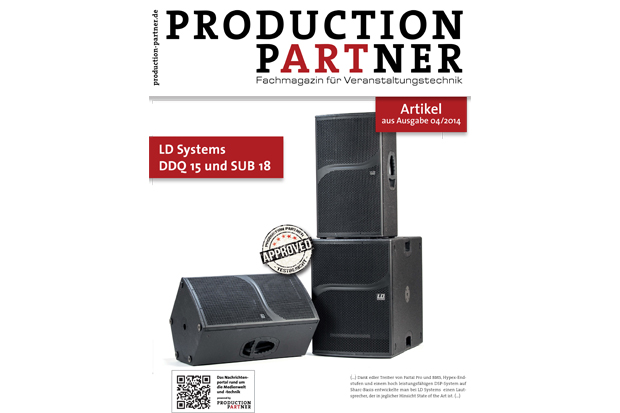 A year ago, LD Systems introduced the DDQ series – consisting of active full-range speakers and powered subwoofers. The DDQ series has been occupying the leading position for some time now, and has recently added a new model, the DDQ 15 at Prolight + Sound. As the name already suggests, there is a 15″ top speaker, that was submitted to our test, together with the also active self-powered SUB 18 subwoofer . The DDQ 15 is the third top speaker in the DDQ series along with the DDQ 12 and DDQ 10. The equipment and technical data of the DDQ 15 clearly identify it as a strong full-range speaker that appears to be best suited to medium-size stages, DJ performances or as an excellent sidefill or drumfill. Together with the SUB 18 or several SUB 18s as a cardioid system, the DDQ 15 turns into a solid PA, that is ready to provide adequate sound for smaller halls or marquees.
A year ago, LD Systems introduced the DDQ series – consisting of active full-range speakers and powered subwoofers. The DDQ series has been occupying the leading position for some time now, and has recently added a new model, the DDQ 15 at Prolight + Sound. As the name already suggests, there is a 15″ top speaker, that was submitted to our test, together with the also active self-powered SUB 18 subwoofer . The DDQ 15 is the third top speaker in the DDQ series along with the DDQ 12 and DDQ 10. The equipment and technical data of the DDQ 15 clearly identify it as a strong full-range speaker that appears to be best suited to medium-size stages, DJ performances or as an excellent sidefill or drumfill. Together with the SUB 18 or several SUB 18s as a cardioid system, the DDQ 15 turns into a solid PA, that is ready to provide adequate sound for smaller halls or marquees.
The objective in the development of the entire DDQ series was clearly the demand for quality. A Konus chassis from Faital Pro and tweeters from BMS are used as drivers. Both brands also belong to the worldwide distribution network of LD Systems products, which makes their use even more sensible. Both brands enjoy a lot of recognition and can be found all over the world in products from renowned manufacturers. In terms of electronics, corresponding suppliers have also been selected. Power amplifiers and power supplies come from Hypex in the Netherlands, whose products enjoy an excellent reputation in the HiFi/ high-end sector. For the filters and limiter functions, LD Systems chose to develop its own DSP board, based on the Sharc processor. All of this will be supplemented by various accessories such as a swivel mount bracket, wall brackets, protective covers and roller boards, which, all things considered, make for a highly professional product. With prices like € 1,599 for the DDQ 15 and € 1,799 for the SUB 18 (both retail prices incl. VAT), the DDQ-series stays very much in a range that is accessible to musicians, clubs and small bands. Distributors are also likely to enjoy the DDQ series not only because of the favourable purchase price, but also because the speakers offer a certain protection against faulty operation through simple configuration and cabling.
 In addition, the reliable protection of the components is ensured by the internal limiter, which is of course exactly matched to the power amplifiers and drivers and can therefore offer a high degree of operational safety. The sum of the previously listed properties makes the DDQ 15 interesting in many respects, which should be reason enough to have a closer look at the new DDQ 15 and the associated SUB 18.
In addition, the reliable protection of the components is ensured by the internal limiter, which is of course exactly matched to the power amplifiers and drivers and can therefore offer a high degree of operational safety. The sum of the previously listed properties makes the DDQ 15 interesting in many respects, which should be reason enough to have a closer look at the new DDQ 15 and the associated SUB 18.
Drivers and Electronics
Let’s begin with the appearance: the housing is made of 15 or 18 mm multiplex, fully covered with a very durable textured black structural lacquer (PU). As expected, the craftsmanship is also perfect in every detail, and small, but important details on the inside have not been forgotten. Thus, the magnet of the tweeter is inserted in a bracket, which protects the horn from accidental damage when carelessly putting down or overturning the speaker. The electronics on the back of the box are located in their own housing, and have no connection to the volume of the woofer. This preserves them from extreme vibration and allows for clearly defined ventilation of the electronics. The cabinet of the DDQ 15 is equipped with two pleasantly large handles on the side, a stand sleeve on the bottom and a total of 13 flight points in M10, to which brackets etc. can also be attached. Solid feet on the bottom and on one of the two back panels allow for secure positioning as a transverse stage monitor. The large bass reflex opening of the bass volume is located to the side of the horn. In the design of a speaker, the bass reflex opening is often a disruptive element that you don’t want to see. However, a large area with little edge length is crucial for its function. The DDQ 15 is quite close to this ideal. Flow noise and compression are thus reduced to a minimum.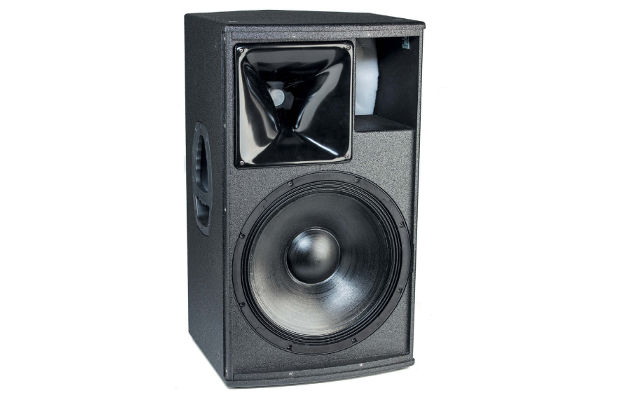
The dimensions of the DDQ 15 cabinet are 42 x 76 x 49 cm (W x H x D). The speaker is of course not that small, but considering the 15″ woofer, it could hardly have been any other way, if the latter is to be used sensibly for the bass sounds reproduction, that is. As a pleasant surprise, the weight is only 32 kg. Considering that the complete electronics is built-in, then the progress made in recent years, in terms of loudspeaker technology, becomes particularly clear: 20 years ago, a similar speaker without electronics would probably have double the weight and the power amplifier would easily have added another 20 kg to the scales. With 32 kg and the well-shaped and sufficiently large handles, the DDQ 15 can easily be handled by one person.
When selecting the drivers, the choice was relatively easy. As a distribution partner for Faital Pro and BMS, here are two brands with a huge range and the latest technology in development and production. They offer everything that a speaker developer could ever wish for. For the low frequency woofers, the choice fell on a neodymium chassis with a 3″ voice coil. These 3″‘ coils are typically used with 15″ or 12″ chassis, which require a low moving mass, thus improving the properties in the mid-range. The heavier 4″ drives, on the other hand, are more often used for pure bass speakers. The powerful neodymium magnet and the futuristic aerodynamic aluminium die-cast basket of the woofer can be recognised at a glance inside the cabinet. An OEM-model of BMS a 1.4″ coil was selected as HF compression driver. Here the classic ferrite magnets were used. There are a few reasons for that: in a tweeter, the weight saved through neodymium is negligible in absolute terms; the heat capacity of the magnet is significantly greater, so that the sensitive voice coil of the tweeter can dissipate its heat faster, and last but not least, ferrite magnets are also much cheaper than neodymium and also less dependent on the current supply situation of rare earths. 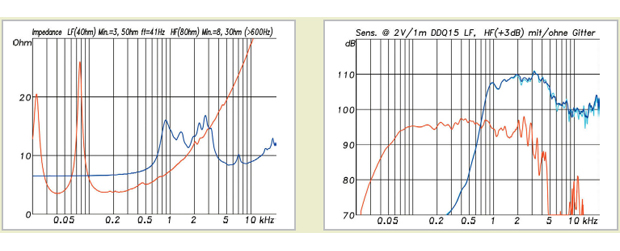 Fig. 1: Impedance curves of the LF (red) and HF (blue) path in the DDQ 15. The 15″ woofer is designed for the optimum utilisation of the power amplifiers as a 4 ohm system. The bass reflex cabinet is tuned to 41 Hz.
Fig. 1: Impedance curves of the LF (red) and HF (blue) path in the DDQ 15. The 15″ woofer is designed for the optimum utilisation of the power amplifiers as a 4 ohm system. The bass reflex cabinet is tuned to 41 Hz.
Fig. 2: Frequency response sensitivity of the LF (red) and HF (blue) route in the DDQ 15, relative to 2 V / 1 m. The 1 W / 1 m value for the 8 ohm tweeter (blue) is 3 dB higher. The dark blue curve shows a measurement without the tweeter grille and the light blue with grille.
As always, with the impedance curve shown in Figure 1, we come to the first measurement. The woofer reveals itself here as a 4 ohm system with a tuning frequency of the bass reflex resonator at 41 Hz. With the 4 ohm chassis, the internal power amplifier can be better exploited when compared to the usual 8 ohm systems. The tweeter is the usual 8 ohm. Here, there is already more than enough amplifier power available, so a lower impedance for more power is not required.
The frequency responses of the two paths in the DDQ 15 in Figure 2 show a consistently good-natured behaviour. The specified cut-off frequency of 1.3 kHz brings both paths together well. The woofer works until well into the mid-range largely resonance free, and above 2 kHz increases evenly and then decreases rapidly. Such behaviour is certainly known to some from the classics EV 15L and 15B, which enjoy a legendary reputation still today. A good chassis is still the best basis for a good speaker in spite of all possibilities of modern electronics. The tweeter is second to none and shows its qualities especially with the highest frequencies. Thanks to the polyester ring diaphragm and to a very light voice coil on a double-sided coiled Kapton support, the driver succeeds at still playing along quite well, even at 20 kHz. The sensitivity in the data sheet is specified at 113 dB. The curve in figure 3 is approximately 3 dB lower, with both curves obtained at 2 V / 1 m, therefore also suitable for the woofer with 1W / 1m. Extrapolated to 2.83 V, the result is also 113 dB.
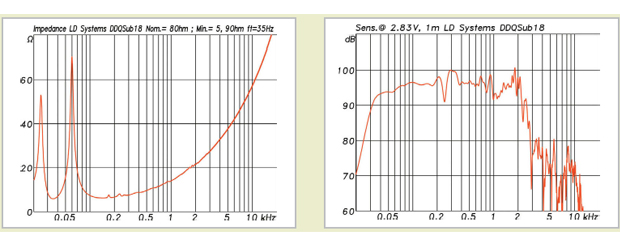 Fig. 3: Impedance curve of 18″ woofer with an impedance minimum of 5.9 ohms and a tuning frequency of 35 Hz.
Fig. 3: Impedance curve of 18″ woofer with an impedance minimum of 5.9 ohms and a tuning frequency of 35 Hz.
Fig. 4: Frequency response with sensitivity of the subwoofer relative to 2.83 V / 1 m. The good news is that the subwoofer can be used quite well up to about 30 Hz.
The two blue curves in Figure 2 show the tweeter with and without front grille. Without grille, the capabilities of the driver stand out even more clearly. The additional undulations with grille are caused by reflections on the grille that run back into the horn and lead to interference and therefore undulations. From an acoustic perspective, it might therefore be better to leave the grille out, but that would not be very practical in everyday use, of course. If you look closely at the grille, it quickly becomes clear that this is the maximum free area possible in order to still achieve the necessary protection. It is not possible to do more than that, therefore, the resulting relatively harmless ripple must be taken into account. Fortunately, the ear is less critical here in its perception than the eye in the contemplation of the curves.
Turning to the back of the DDQ 15, where you will find the electronics with all the controls built-in. The mains connection is a lockable IEC socket. For the audio signal, there is an XLR socket with link output and an additional output for an external subwoofer. If the “subwoofer” setting is activated, a high-pass filter at 110 Hz (Butterworth 18 dB) is inserted in the signal path of the DDQ 15 and the corresponding low-pass filter is activated in the output for the subwoofer. The subwoofer output is designed for connection to any subwoofer without their own low-pass filtering. Subwoofers from the DDQ series already have the appropriate filter internally and are therefore connected in parallel to the top speaker and not to the subwoofer output.
An additional built-in switch activates the ground lift. A total of four LEDs indicate Signal Present, Peak-Limit, Subwoofer Mode, and Operate. The analogue input of the DDQ 15 is designed for levels up to a maximum +23 dBu, which provides sufficient security against overload for all everyday applications. Via a rotary encoder, a digital Gain can be adjusted from -34 to +23 dB. If the encoder is set to 0 dB, then the speaker fully reaches +23 dBu at the input. In the Gain setting +23 dB, full power is reached at 0 dBu at the input, which will also still be sufficient for weak levelled sources. The wide Gain range with a fixed analogue clipping threshold of +23 dBu is made possible by a stacked A/D converter in the input with a 127 dB dynamic range, without any noise problems.
The operation of the DDQ 15 is kept very simple. Meaning no PC interface, no EQs, no delays etc., which would have been possible with the internal DSP system. Anyone familiar with the market, knows, however, that nobody hardly ever uses these functions and accidental use is much more likely than a necessary one. Provided that the internal filter and limiter are tuned properly, there is in fact hardly any reason for the end-user to make further filter adjustments. Possible custom filters or differentiated EQs for music, DJ, language, etc. could of course be made available via presets, but it is also the case here that the probability of operator error exceeds voluntary use. Those who would like a special sound, could and should adjust it on a console. The speaker will always remain the neutral broadcasting tool.
If you unscrew and take the electronics out of the housing, which is removable as a complete unit, you will see dense and cleanly built electronics. The picture is dominated by two Hypex UcD 700 modules and the associated 1.2 kW power supply, the DSP-board is hidden in the bottom right.
DDQ SUB 18
The DDQ 15 was supplied with a typical subwoofer SUB 18 as a complement. The electronics module is identical to the one of the speaker, with the only difference in the configuration being that the two UcD 700 power amplifiers control the 18″ driver in a bridge circuit.
For the driver, they chose a model from Faital Pro with 18″ nominal dimension and a 4″ coil in the drive. Thanks to a neodymium magnet, the weight has again been reduced. However, a certain cabinet size remains indispensable for a subwoofer, so that the SUB 18 still weighs 44.5 kg on the scales. Despite the three large recessed handlebars on the edges, you would need two people for transport and set-up of the unit. The optional roller board provides some relief.
The impedance curve from Figure 3 reveals a tuning frequency of 35 Hz and the frequency response in Figure 4 shows a usable lower cut-off frequency of 30 Hz. The sensitivity up to 100 Hz is about 95 dB.
Controller
The integrated digital controller in the DDQ series is identical in all models and is based on a SHARC DSP with a Cirrus Logic 42526 AD/DA Converter. The Cirrus chip has two ADCs and six DACs. The two ADCs are operated according to the principle of the stacked transducer and reach an input dynamic of 127 dB. On the output side, two DACs are used in parallel, which improves the dynamic range by 3 dB compared with a single DAC, which leads to an output dynamics of 113 dB, that can be implemented by the Hypex power amps without loss.
At this point, the question may arise,why have a 127 dB input dynamics when on the output side of the DSPs, only 113 dB are needed? The input can be designed on +23 dBu maximum level, and the gain can be set internally on a digital level within certain limits without loss. A clipping of the input is next to impossible. Signals with low level can then easily be reproduced on the digital level with a maximum gain of 23 dB, which should be sufficient for all standard applications.
In the top speaker, the three outputsof the DSP system are used for the LF and HF path, as well as for the subwoofer aux output. The latter must only be used if you want to connect a subwoofer that is not from the DDQ series. The DDQ Subs have their own DSP and already work in the default setting (Preset 1) with the appropriate filter for a combination with the DDQ speakers. For use as a mono subwoofer, the DDQ subs have two inputs, both with link output that can be added internally. For other combinations outside of the DDQ series, there are other presets (2 to 7) with low-pass filters from 80 to 120 Hertz. An auxiliary output can also be found here, but now with a high-pass filter for any other speaker.
If you stay within the DDQ series, theneverything is so simple. The subwoofer or subwoofers will get the signal from the console and forward it to the link output 1:1. For the subwoofer, Preset 1 is chosen and the LowCut switch on the top speaker is activated. In addition to the already mentioned presets, there are also some mysterious presets A1/2, B1/2, C1/2, D1/2 on the subwoofers. With these setups, you can build a cardioid system with two or three subwoofers.
 Fig. 5: Filter frequency responses of the built-in controller amps. For the DDQ SUB 18 in green, the LF path in the DDQ 15 in red and for the tweeter in blue. The dashed red curve shows in its course the combination with a subwoofer in the LowCut setting.
Fig. 5: Filter frequency responses of the built-in controller amps. For the DDQ SUB 18 in green, the LF path in the DDQ 15 in red and for the tweeter in blue. The dashed red curve shows in its course the combination with a subwoofer in the LowCut setting.
Fig. 6: Frequency response of the DDQ 15 in the Full-range and LowCut modes (dashed). In red and blue, the curves for bass or tweeter are measured separately.
The functions of the internal filter,are shown in Figure 5. The green curve shows the filter for the subwoofer with the DDQ Preset 1. The red curves are for the woofer in the DDQ 15 in Full-range and LowCut modes and the blue curve is for the tweeter. In addition to the high- and low-pass filters, there are still some Bellfilters for correction of the frequency responses and here delays that are not visible for the runtime adjustment.
Measured values
If you look at the DDQ 15 as a whole, then Figure 6 retraces the sequence. There is hardly anything to add: here, it fits in all frequency ranges. The sequence from the lower cut-off frequency ( -6 dB) at 42 Hz up to 20 kHz is quite extended and the ripple is extremely low. With the LowCut filter, the lower cut-off frequency moves to 90 Hz, which makes it noticeably easier for the woofer in the DDQ 15.
The associated phase frequency responses in Figure7, also show a harmonious interplay of tweeters and woofers in the DDQ 15. The phase frequency responses of the two paths in red for the woofer and in blue for the tweeter are not only meeting in the crossover frequency, but also coincide in the whole frequency range of 800 Hz to 2 Khz Only if the phases of both paths coincide around the crossover frequency, does this result in a smooth sum frequency response as can be seen in Figure 6.
In the spectrogram in Figure 8, the DDQ 15 appears inconspicuous. Up to 1 kHz, there is here and there a small resonance, which probably is due to the enclosure volume and it can never be totally avoided if a large woofer is used well into the mid range. The tweeter operates almost resonance-free, which should be thanks to the ring diaphragm concept of the BMS driver.
 Fig. 7: Phase frequency responses of the DDQ 15 in the full-range mode. In red and blue,the curves for bass or tweeter are measured separately. In the transition areaat 1.2 kHz both paths match perfectly.
Fig. 7: Phase frequency responses of the DDQ 15 in the full-range mode. In red and blue,the curves for bass or tweeter are measured separately. In the transition areaat 1.2 kHz both paths match perfectly.
Fig. 8: Spectrogram of the DDQ 15. There are a couple of small resonances,especially in the frequency range of the woofer, but none are critical.
With the SUB 18, a third path is added. Figure 9 shows the interaction of the top speaker and subwoofer in the full-range mode in comparison with the top speaker in full-range mode. The gain to the lowest frequencies does not look as spectacular as you might expect: the lower cut-off frequency decreases from 42 Hz to 32 Hz, but this is not because the subwoofer does not go low enough, but has to do with the DDQ 15 being already quite strong in the bass. Depending on the type of music, e.g.electronic music or DJ program, the extra 10 Hz becomes quite noticeable.
However, the actual benefits of the subwoofer combination lies elsewhere. The woofer in the DDQ 15 is significantly relieved from the low frequencies and thus from large displacements, which also lessens the distortions in the mids. In addition, there is also the generally higher maximal level of the subwoofer in the frequency range below 100 Hz.
 Fig. 9: Frequency response of DDQ 15 in the LowCut mode (blue) withSUB 18 (red) extension. In dashed green, again the comparisonto the DDQ15 in full range mode.
Fig. 9: Frequency response of DDQ 15 in the LowCut mode (blue) withSUB 18 (red) extension. In dashed green, again the comparisonto the DDQ15 in full range mode.
Fig. 10: Horizontal isobars of the DDQ 15 with a dispersion angle of80 x 50 degrees. The 80° will be respected for the mids above 1 kHz. With the highest frequencies, a somewhat stricterbundling occurs.
Directivity
In the data sheet, the dispersion pattern of the DDQ 15 is stated to be 80 x 50. As can be seen from the shape of the high-frequency horn, the dispersion pattern is designed asymmetrically. If one moves through the vertical plane in front of the enclosure from bottom to top, the horizontal dispersion angle attained becomes narrower from bottom to top. In practice, this means: right in front of the stage, the dispersion angle is wider than in the public areas situated further back. If the speaker is lying across the stage and used as a stage monitor, then the horn can be rotated by 90° and you can make use of its asymmetric behaviour on stage.
Figs. 10 and 11 show the isobars with reference to the central axis of the enclosure. Horizontally, 80° is attained starting from approx. 1000 Hz upwards and is then maintained up to 10 kHz. Above this, increasing bundling begins. Vertically, the isobars behave slightly roughly and only partially do they achieve the nominal 50°. The interferences in the transition area at 1.3 kHz are moderate and also symmetrical to the centre axis.
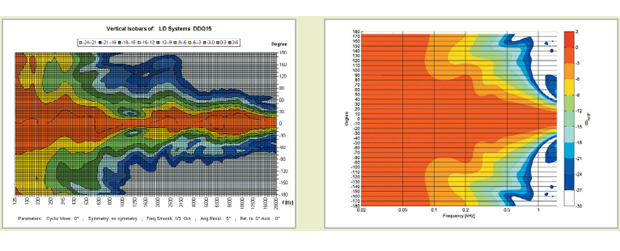 Fig. 11: Vertical isobars of the DDQ 15, the tweeter shows asomewhat turbulent path.
Fig. 11: Vertical isobars of the DDQ 15, the tweeter shows asomewhat turbulent path.
Fig. 12: Simulated isobar curves of a single SUB 18.
Cardioid Subs
The possibility of a cardioid set-up with two or three subwoofers has already been mentioned on the subject of controller settings. Low frequencies coming normally from a source which is considerably smaller than the wavelength, spread almost spherically. But for most applications, it would be desirable and useful, also to achieve a certain directivity, especially here. This can be achieved either through huge speakers, huge horns or by an appropriate arrangement and control of multiple small sources.
In the manual of the SUB 18, four such arrangements are proposed. In setup A, two subs are stacked and the upper emits to the back. In variants B and C, there are three subs, of which the middle one emits to the back. For B, the three subs are on top of one another, for C, they are side by side. Variant D works again with two subs, both standing in a row with a 1 m distance between them, and broadcasting forward. To select the proper setup, make sure that the forward emitting subs are on Setup 1 and those emitting to the back, Setup 2. In the set-ups, the appropriate filter and delays are adjusted so that the backward emitting low frequencies are eliminated to a large extent. The levels emitted forward are slightly reduced compared to an arrangement of completely forward-facing units.
The isobar curves in Figure 12 to 14 show the possibilities with two or three systems. A single 18″ subwoofer (Fig. 12) emits evenly all round, below 100 Hz. When using the 2 or 3 cardioid arrangement, as shown in Fig. 13 and 14, the level emitted to the back is reduced by 15 dB and more. Values of this magnitude add an invaluable advantage when it comes to avoiding feedback problems with the many microphones on stage or at open-air events, to reduce the acoustic noise behind the stage for the neighbours. The benefits of the cardioid subwoofer arrangements are also not to be underestimated in reverberant rooms or large concert halls where space is less stimulated and the bass reproduction is accordingly more precise. How well the cardioid bass works in practice depends on the environment around the speakers: as far as possible it should be free. Free, meaning low frequencies where for example, trusses and the like should not constitute an obstacle in relation to the wavelength. Massive walls or other large speakers should preferably not be in the direct vicinity.
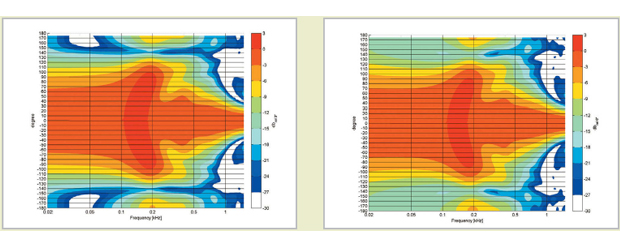 Fig. 13 and 14: Simulated isobar curves of two SUB 18 units in cardioid mode.
Fig. 13 and 14: Simulated isobar curves of two SUB 18 units in cardioid mode.
Maximum level and distortion values: How loud “can” a speaker be?
How loud “can” a speaker be? This is a frequently asked question and how can you compare a maximum level of model A with that of model B? The second question is quickly answered: not at all! Every vendor has their own way of determining their values. And without detailed information about how such values are created, a comparison is impossible.
For the achievable maximum level, there are a number of factors. For one, there is the sensitivity of the speaker, the available amplifier power or max. load capacity of the speaker, the accepted distortions and also possibly limiters in the signal path. It is not only for a short-time measurement, but for a real continuous operation, then even factors such as heat dissipation and power rating of the power supply play a role – especially for speakers with integrated amplifiers.
Here, LD Systems decided on security. The power supply unit in the DDQ 15 is designed for 1.2 kW short-term amplifier power and is thus ample sized. When it comes to peak values, the limiters in the DSP are based on border values for clipping on the amplifiers and the max. load of the drivers, which is relevant mainly for the HF driver. The same applies to the RMS limiter, which, for one thing, takes into account the RMS continuous power of amplifiers and power supplies and of course also the thermal durability of the driver. The HF driver is also the most sensitive point, of course. In the case of the 15″ woofer or the 18″ chassis in the subwoofer, the limit is related more to the electronics than to the drivers.
Even class D power amplifiers generate heat, although significantly less than conventional class AB-circuits. The back panel of the electronics alone would not be sufficient for the permanent evacuation of the heat. An outside heat sink would be effective but unpleasant to look at. If the heat sink is inside, then the effect is irrelevant. As an effective and safe solution, there remains only the forced ventilation.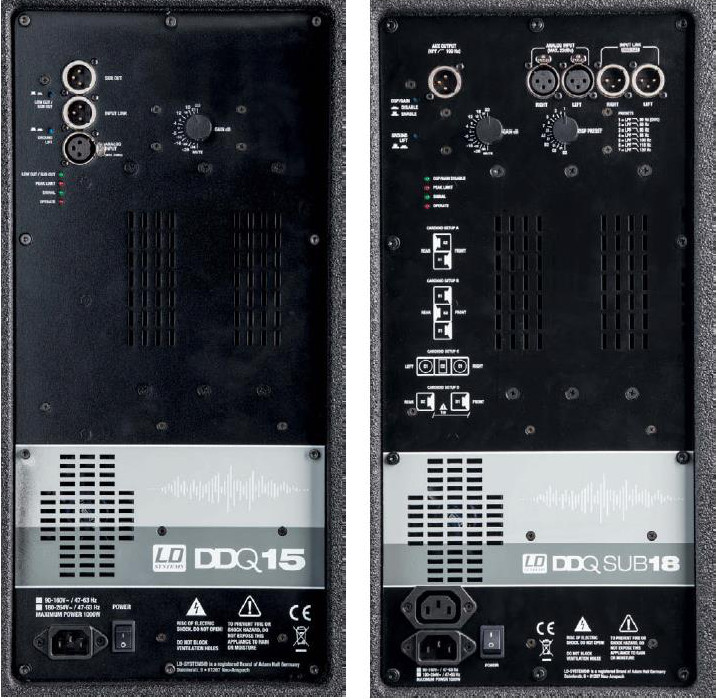
The heat sink for the power amplifiers is attached with its ribs on the inside on the rear panel, with an opening to the outside. A small, quiet running fan draws in cold air from outside and creates an overpressure in the housing, which then escapes through the cooling fins to the outside again. In this way, the electronics can also be cooled safely and unobtrusively for continuous operation. The fan works deliberately without any control and is always set at maximum speed. The resulting noise is hardly noticeable and the electronics are always cooled as much as possible, which extends their product life. If the fan was only switched on when a certain temperature has been reached, the average temperature would be noticeably higher over a long period of time. Anyone who knows the relationship between the product life of electronics and temperature, knows only too well what that means.
Back to the topic of distortion measurement: in the first step, maximum level measurements with sine wave bursts of not more than 3% and with distortions of not more than 10% were carried out for the DDQs. Here, the harmonic components k2 to k9 are evaluated. The measurement algorithm increases the level until the corresponding distortion limit of 3% or 10% is reached. A performance limit for the speaker or the detection of limiter in the system can be used as third termination criterion. Figure 15 shows the result with the blue curve for a maximum of 3% distortion and with the red curve for the 10% limit. At the points wherethe two curves meet, thedistortion limits were not reached before the internal limiter stopped the measurement. The dashed curves were measured with a combination of DDQ 15 with a SUB 18 subwoofer. The woofer of the DDQ 15 is measured here in the range of 122 dB, which is 1-2 dB below the possible theoretical value, resulting from the sensitivity and the maximum amplifier power of 700 W (+28.45 dB). The tweeter is internally limited to 40 W of continuous power and 160 W of peak power. As usual with compression drivers, a limitation in measurement occurs already below mathematically possible values, due to the 10% distortion limit. The 10 dB difference between the 3% and the 10% curve is an indication of good k2-dominated distortions. Back to the woofer: The Faital driver shows here its abilities, especially at low frequencies. Even at 60 Hz, 120 dB are achieved. When the SUB 18 comes into play, you can again considerably increase the values up to 128 dB, below 100 Hz.
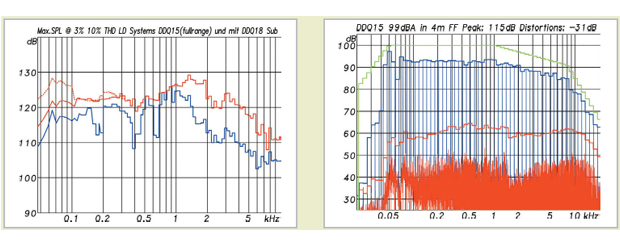 Fig. 15: Maximum level for a maximum of 3% (blue) THD, and not more than 10% (red) THD. Dashed red indicates the combination with a SUB 18.
Fig. 15: Maximum level for a maximum of 3% (blue) THD, and not more than 10% (red) THD. Dashed red indicates the combination with a SUB 18.
Fig. 16: Intermodulation distortion for a Leq of 99 dBA at a distance of4 m. As excitation signal, a multi sine signal withEIA-426B spectrum (green) and 12 dB crest factor was used. In red, thedistortion components with a share of only 2.8%. The measuredpeak level in relation to 1 m distance was 127 dB(the measurement was taken at a distance of 4 m in half-space conditions. The blue spectrum therefore corresponds to a global level of105 dBA).
The second measurement on the subject of non-lineardistortions uses a multi sine signal for the distortion analysis. The signal is composed of 60 sinusoidal signals with random phase and is therefore a medium-sized music spectrum weighted according to EIA-426-B. The crest factor of the signal is 12 dB and is thus also very close to a normal audio signal.
The green curve from Figure 16 represents the frequency weighting of the measuring signal. The blue lines or the 1/6 octave band cumulative curve show the signal transmitted through the loudspeakers. The red lines and cumulative curve contain only the distortion components consisting of the harmonic distortions and all inter modulation distortions.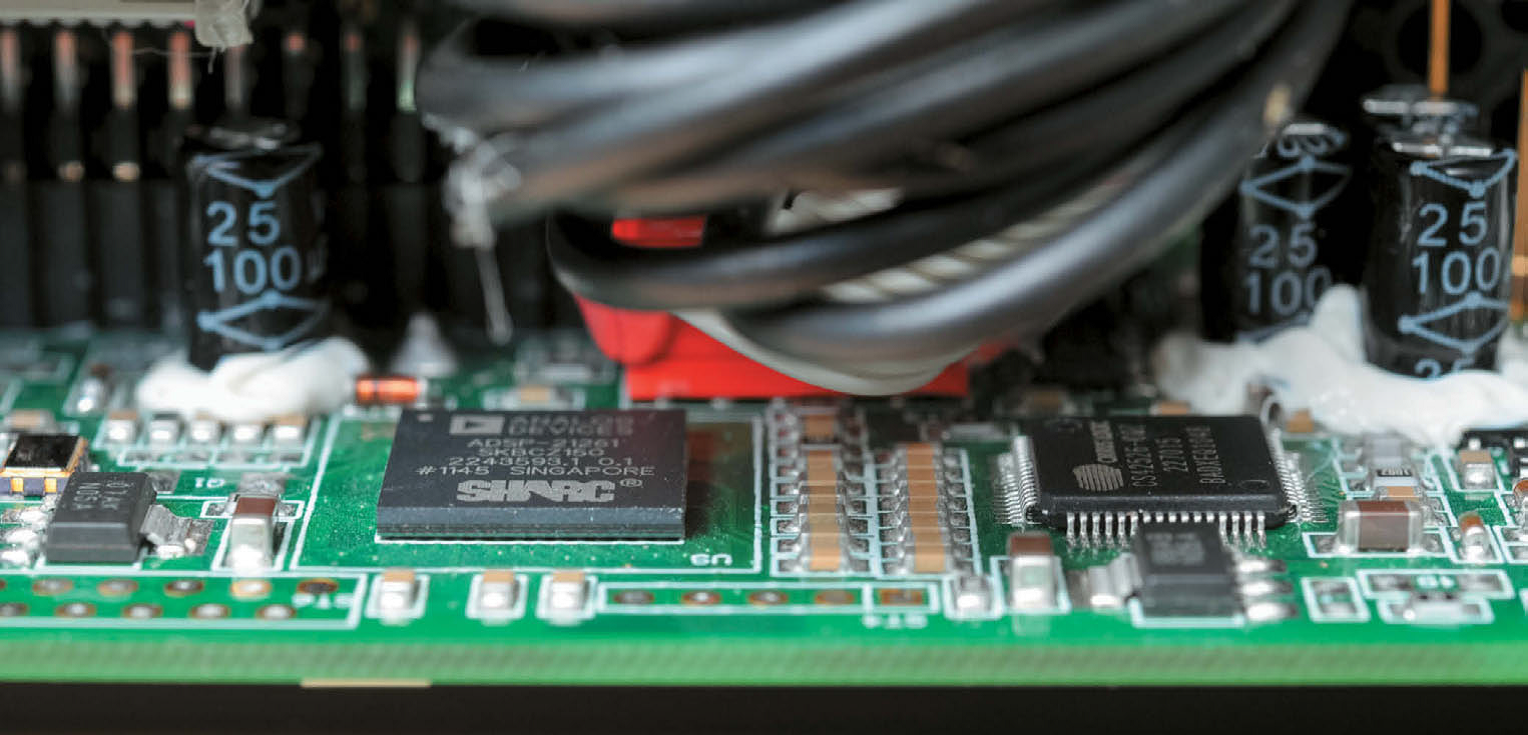
The measurement is typically performed for a usual signal level, which comes close to real operating conditions. For the DDQ 15, a level of 99 dBA at a distance of 4 m was set in free-field conditions. The level is to be understood here as LAeq (energy equivalent continuous sound level). The linear weighted level is approx. 3 dB higher. For the peak value, 12 dB are to be added on top. This meant for the DDQ 15, 115 dB peak level at a distance of 4 m corresponding to 127 dB at 1 m. The overall measured distortions at -31 dB (2.8%) were very low. The DDQ 15 is however not yet at full capacity. If you drive the speaker to the limit with this signal, then 105 dBA Leq at a distance of 4 m and 120 dBpk are achieved. In relation to 1 m, this is a peak of 132 dB. The distortions at this level are at 11.2%.
As a user, you can estimate that these values are possible under extreme conditions, meaning free-field without the support of a room, 99 dBA Leq at 8 m with one speaker. Judging by two top speakers (+3 dB) as a stereo set, then the distance becomes 11.3 m and with the support of a room (+2-3 dB) 16 m. Whoever deals with level measurements, knows that 99 dBA as Leq are already tremendously loud and also that the legal upper limit for the protection of the public is 99 dBA Leq. Therefore, we can say without question, that the DDQ 15 is fully suitable for smaller clubs and similar locations as a PA. Then one or the other subwoofer can be supplemented, depending on the music material and requirements in the bass level.
Listening test
The listening test of the DDQ 15 took place in the anechoic room, as is well-known. Both variants with and without support through the subwoofer SUB 18 were heard. There is no need for long words in the tonal description: the DDQ 15 is wonderfully neutral, exactly as you would like it to be. The bass ranged so far down that you would have been quite inclined to suspect the subwoofer was on, even if this was not yet enabled. The high frequency range is finely resolved and pleasant, as we can expect from a BMS driver. The positioning of the sources was also convincing. The mids were precisely outlined and the depth in the recordings were clearly perceptible. With a subwoofer, the differences were initially rather low. Only when it came to real deep bass (such as Kraftwerk’s Tour de France), was the extension by 10 Hz downwards really felt. The differences became significant, when the level was increased. Then, the SUB 18 can play to its strengths and at the same time relieve the top speaker, which in contemporary jargon is expressed as a real win-win situation.
Conclusion
With the new top speaker DDQ 15, LD Systems expands its DDQ series of active self-powered speakers introduced only a year ago. The powerful full-range top speaker was put to the test, together with the SUB 18 and made an outstanding impression in every way. Thanks to noble drivers from Faital Pro and BMS, Hypex power amps and a high-performance DSP system based on the Sharc, LD Systems presents a state-of-the-art loudspeaker, in every respect. Everything from the measurement values over to the handling up to the solid craftsmanship is impeccable. Also the operation and combination of the systems was solved elegantly and plausibly, which is extremely important in everyday life, as even the best speaker is useless if, in the excitement just before a gig, an incorrect configuration is set or a correct configuration is incorrectly wired. The DDQ 15, even without the support of the subwoofer, is already a very powerful and potent speaker in the bass range, and can easily be used on its own on small stages. Together with the subwoofer(s), it becomes a real PA, even suitable for a marquee. The benefits of the ability to configure the subwoofer as a cardioid are not to be underestimated for day-to-day operation. With two top speakers and three subs as a mono cardioid bass lying across or under the stage, you can achieve a great deal.
Also, the peripheral aspects such as easy transportation or meaningful accessories are very positive, and, last but not least the extremely favourable price: a DDQ 15 costs € 1,600.00 (incl. VAT), a SUB 18 approximately € 1,800.00. For just over € 10,000.00 retail price incl. VAT you already have a complete set with two DDQ 15 top speakers and four SUB 18s; everyone can easily imagine the range of available applications.
For more information on these products:
http://www.ld-systems.com/en/series/ddq-series/
Source: Production Partner, Germany, April 2014
Text and Measurements: Anselm Goertz
Photos: Dieter Stork, Anselm Goertz
Leave a Comment
You must be logged in to post a comment.












